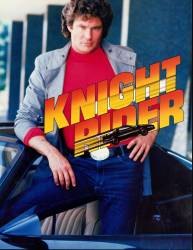Continuity mistake: When Michael is getting Dr. Bergstrom out of Goliath, he steps onto K.I.T.T.'s hood and Bergstrom is to his right, in the next shot Bergstrom is to his left.
Continuity mistake: When Michael and Dr. Bergstrom get out of Goliath, the back door is still open. We see both get into K.I.T.T. at the same time since Bergstrom needs Michael's help walking on the hood. But once they're both in the car, the back door is closed and locked without Michael having a chance to. And if the door can close automatically or remotely, then it should have closed with Michael inside.
Continuity mistake: Right after Michael escapes from his cell, he finds KITT in the garage. Michael has KITT pop his hood to work on him, he asks KITT how he feels, the next shot shows KITT's scanner with the hood down, then it goes back to the shot of Michael and the hood is open again.






Chosen answer: Before "product placement" became common, name-brand products were rarely, if ever seen in TV shows, mostly due to avoid advertising conflicts with program sponsors. The Pepsi logo may have been taped out to prevent any commercial infringements.
raywest ★
Are you kidding? Product placement was so rampant in the 50s that sometimes you'd wonder if you were watching a TV show or a paid ad.
Brian Katcher
Knight Rider wasn't produced in the 1950s. TV shows of that era had advertising more similar to the old radio shows from the 30s and 40s. The early 50s series often had a sole sponsor, so their product (and related items) was likely seen in a program. An announcer also informed the audience at the beginning that, "This program is brought to you by (insert brand name). " From the 60s on, brand-name products weren't generally seen in TV programs. Networks sold air time to multiple advertisers, and their ads were shown during the long commercial breaks. So no, I'm not kidding.
raywest ★